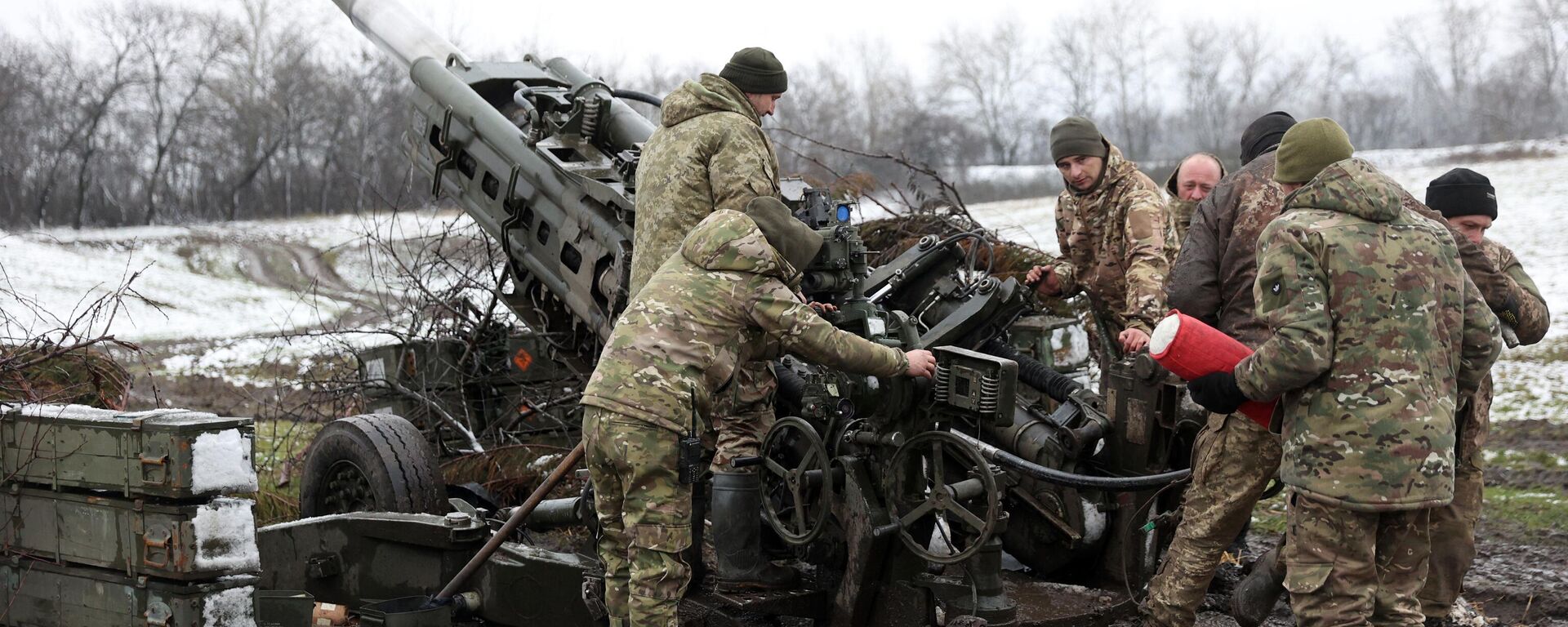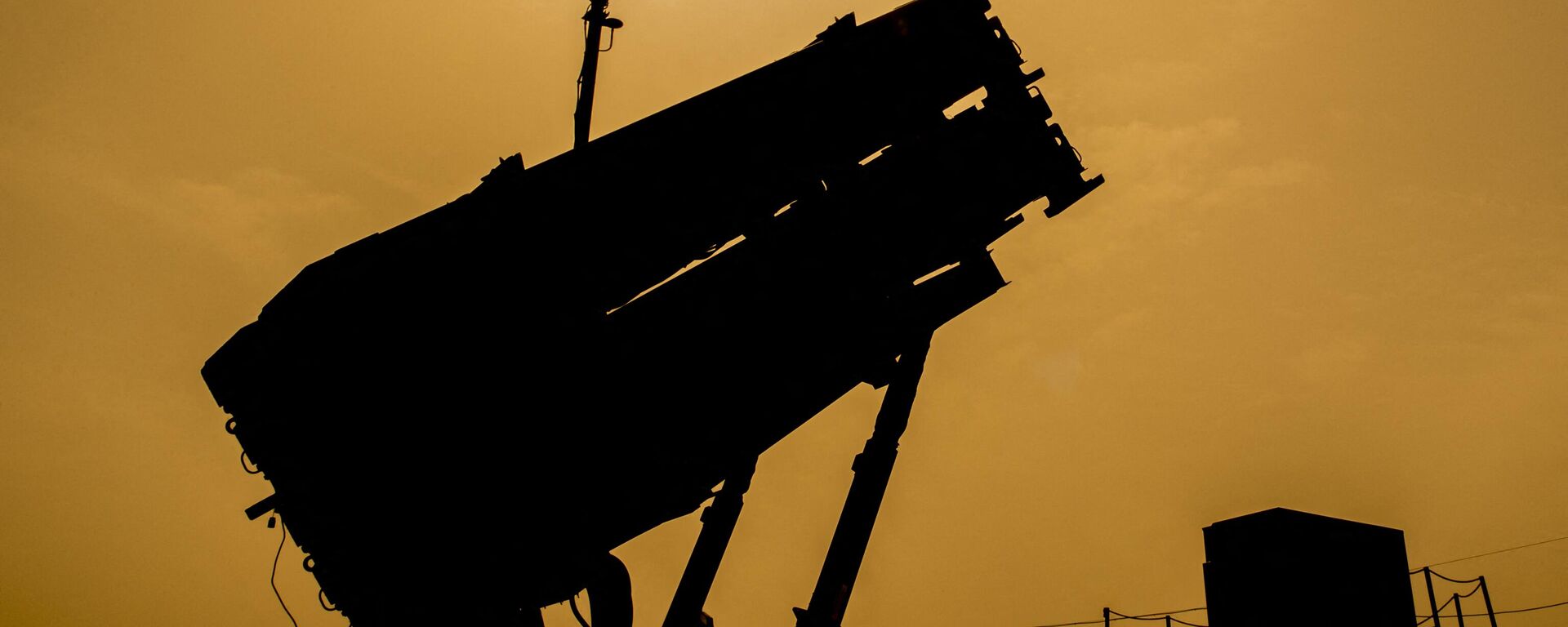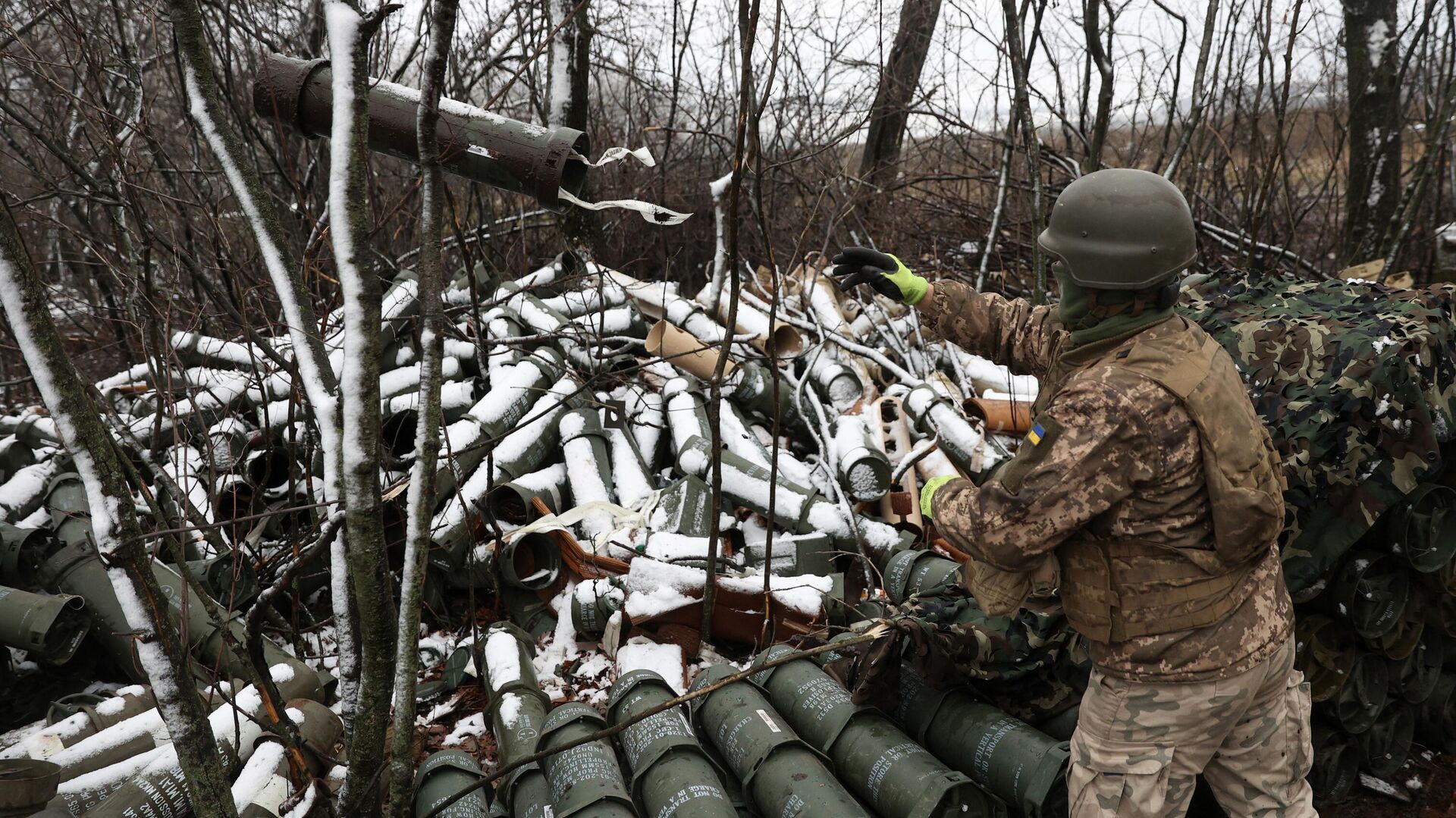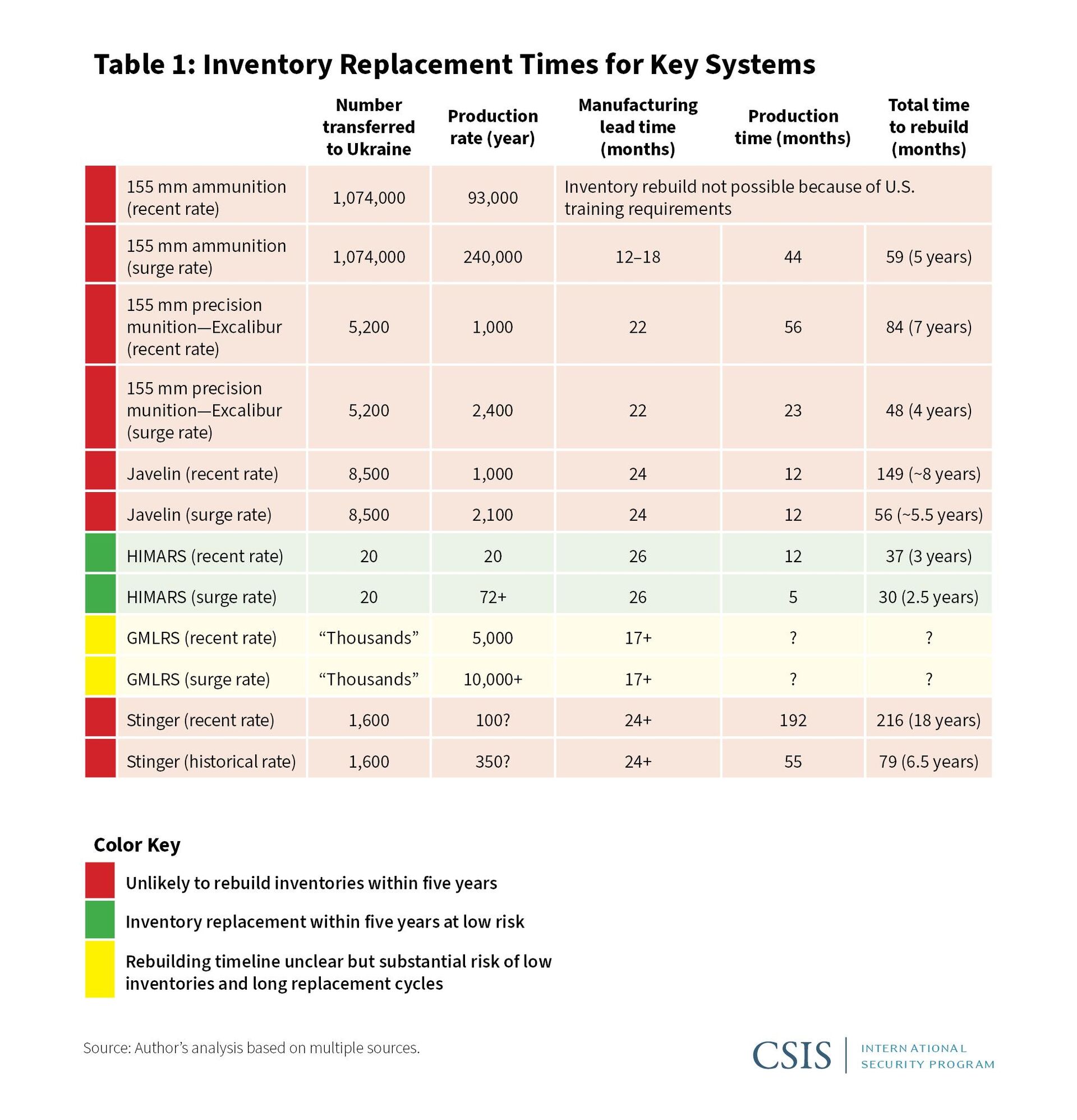https://sputnikglobe.com/20230120/weapons-sent-to-kiev-could-take-us-nearly-half-a-century-to-replenish-retired-officer-warns-1106534777.html
Some Weapons Sent to Kiev Could Take US ‘Nearly Half a Century’ to Replenish, Retired Officer Warns
Some Weapons Sent to Kiev Could Take US ‘Nearly Half a Century’ to Replenish, Retired Officer Warns
Sputnik International
The US has now sent nearly $27 billion in arms to Kiev since last February, with its allies chipping in over $9 billion more.
2023-01-20T17:31+0000
2023-01-20T17:31+0000
2023-01-20T18:13+0000
ukraine
us
weapons
arms
aid
assistance
russia
proxy war
security
https://cdn1.img.sputnikglobe.com/img/07e7/01/14/1106534441_0:175:3019:1873_1920x0_80_0_0_a0f76fa75edd7f063e327607e584b711.jpg
Large-scale US arms deliveries to Kiev threaten to undermine Washington’s national security and warfighting ability by depleting critical weapons stockpiles, says David T. Pyne, former US Army combat arms and headquarters staff officer.This week, a source familiar with Western intelligence characterized the Ukraine crisis as a unique opportunity for “real-world battle testing” of a type previously unseen in the asymmetric US-led wars in places like Afghanistan, Iraq, or Libya, since it allows the Pentagon to examine the performance of weapons against a near peer adversary without risking American lives. Ukraine is “a weapons lab in every sense because none of this equipment has ever actually been used in a war between two industrially developed nations,” the source said in an interview with US media.The comments echoed remarks made by Ukrainian Defense Minister Oleksii Reznikov earlier this month, with the official openly characterizing Ukraine as a proving ground for Western arms, and praised the “combat testing” afforded by the defense cooperation between Kiev and its NATO partners.Neither Reznikov nor US media has elaborated on the grisly costs of this “combat testing” – including the Ukrainian and Russian servicemen killed or wounded, and Kiev’s use of its Western-provided artillery, rocket, and missile systems to relentlessly shell civilian areas in Donbass.Praising Washington for at least not being “foolish enough” to deploy combat troops in Ukraine and expressing hope that it will stay this way, Pyne stressed that Washington and its allies have nonetheless been undermining their own strategic security through the vast quantities of weapons sent Kiev’s way.Security ShortfallUS media have published report after damning report in recent months on the impact the Ukraine crisis has had in straining the US and Europe’s defense capabilities, with one anonymous NATO official saying recently that “everyone is now sufficiently worried” as the conflict grinds on and stockpiles threaten to plunge below levels required to meet NATO defense obligations.Calculations by the Washington-based Center for Strategic and International Studies think tank this month found that it may take the Pentagon between three and eighteen years to replenish stocks of a broad array of ammunition, including 155 mm artillery shells, Javelin anti-tank missile systems, Stinger shoulder-launched air defense systems, and High Mobility Artillery Rocket System (HIMARS) rockets.The problem has apparently had an impact on the US’ allies as well, with the DoD reportedly tapping weapons stockpiled in Israel to send to Ukraine. Tel Aviv has relied on generous US military aid since the 1970s as one of its main guarantees of security in a hostile region amid the ongoing Israeli-Palestinian conflict, Israel’s illegal occupation of Syria’s Golan Heights, and decades of tensions with Iran and Lebanon’s Hezbollah militia movement.Senior US officials have largely remained tight-lipped about the impact the flow of arms to Ukraine has had on America’s military-industrial base. However, last week, US Navy Secretary Carlos Del Toro admitted that if the Ukrainian crisis were to go on for another six months to a year, it would “stress” the supply chain “in ways that are challenging,” with new capital investments required to ramp up production.Weapons Black HoleThe worst thing about the current situation, according to Pyne, is that Washington and its allies usually have little to no idea where the weapons being sent to Kiev are actually going.Pyne speculates that “much of the rest” of the aforementioned aid was “likely being sold off on the black market to enrich corrupt Ukrainian billionaire oligarchs and Ukrainian government officials including President Zelensky…I don’t believe that the US Department of Defense is taking any adequate measures to ensure the weapons we have sent Ukraine are actually reaching Ukrainian soldiers,” he said.Ignorance of Own Red LinesAs the conflict continues to escalate and NATO mulls the deployment of more and more exotic weapons systems, Pyne fears that the Biden administration’s apparent lack of “any coherent strategy or achievable aims” with regard to the conflict may exacerbate the threat.Ultimately, citing US and NATO hesitation to send large numbers of tanks or fourth generation fighters to Kiev, Pyne expressed confidence that the existing deliveries “are unlikely to change the correlation of forces” in the conflict, which he said Russia was “favored to win” owing to its bigger economy and population, “as well as marked superiority…in terms of airpower, artillery and armor.”The retired officer expects Russia to possibly gain numerical superiority on the battlefield once partial mobilization is complete, and said the inflow of half a million Russian troops will allow Moscow to liberate the remainder of Donbass “and force the Ukrainian government to accept the Kremlin’s offer of a negotiated peace settlement later this year, thus largely achieving the objectives of Russia’s special military operation.”
https://sputnikglobe.com/20230116/ukraine-is-test-lab-for-western-weapons-in-every-sense-report-1106390198.html
https://sputnikglobe.com/20230112/supply-chain-issues-to-worsen-if-ukraine-conflict-continues-another-year---navy-secretary-1106240373.html
https://sputnikglobe.com/20241121/russias-special-military-operation-in-ukraine-and-how-it-is-progressing-1105665248.html
ukraine
russia
Sputnik International
feedback@sputniknews.com
+74956456601
MIA „Rossiya Segodnya“
2023
News
en_EN
Sputnik International
feedback@sputniknews.com
+74956456601
MIA „Rossiya Segodnya“
Sputnik International
feedback@sputniknews.com
+74956456601
MIA „Rossiya Segodnya“
ukraine, us, united states, military aid, military assistance, arms assistance, arms, aid, military, weapons, weapons aid, dangers, great power competition, how much us spends on ukraine, how many weapons us sends to ukraine, what weapons us supplies to ukraine
ukraine, us, united states, military aid, military assistance, arms assistance, arms, aid, military, weapons, weapons aid, dangers, great power competition, how much us spends on ukraine, how many weapons us sends to ukraine, what weapons us supplies to ukraine
Some Weapons Sent to Kiev Could Take US ‘Nearly Half a Century’ to Replenish, Retired Officer Warns
17:31 GMT 20.01.2023 (Updated: 18:13 GMT 20.01.2023) Washington unveiled $2.5 billion in new weapons aid to Ukraine this week, including 59 Bradley and 90 Stryker vehicles, 350 Humvees, and tens of thousands of rounds of artillery, anti-tank and anti-aircraft munitions. The US has now sent nearly $27 billion in arms to Kiev since last February, with its allies chipping in over $9 billion more.
Large-scale US arms deliveries to Kiev threaten to undermine Washington’s national security and warfighting ability by depleting critical weapons stockpiles, says David T. Pyne, former US Army combat arms and headquarters staff officer.
This week, a source familiar with Western intelligence characterized the Ukraine crisis as a unique opportunity for “real-world battle testing” of a type previously unseen in the asymmetric US-led wars in places like Afghanistan, Iraq, or Libya, since it allows the Pentagon to examine the performance of weapons against a near peer adversary without risking American lives. Ukraine is “a weapons lab in every sense because none of this equipment has ever actually been used in a war between two industrially developed nations,” the source
said in an interview with US media.
The comments echoed remarks made by Ukrainian Defense Minister Oleksii Reznikov earlier this month, with the official
openly characterizing Ukraine as a proving ground for Western arms, and praised the “combat testing” afforded by the defense cooperation between Kiev and its NATO partners.
Neither Reznikov nor US media has elaborated on the grisly costs of this “combat testing” – including the Ukrainian and Russian servicemen killed or wounded, and Kiev’s use of its Western-provided artillery, rocket, and missile systems to relentlessly shell civilian areas in Donbass.

16 January 2023, 10:40 GMT
“The Biden administration has declared its objective to use its proxy war against Moscow to weaken Russia militarily and essentially utilize Ukrainian soldiers and civilians as cannon fodder for the purpose of ensuring Ukraine remains a de facto NATO member and fighting the war for years to come at Ukraine’s expense,” Pyne said, referencing the “testing ground” commentary.
Praising Washington for at least not being “foolish enough” to deploy combat troops in Ukraine and expressing hope that it will stay this way, Pyne stressed that Washington and its allies have nonetheless been undermining their own strategic security through the vast quantities of weapons sent Kiev’s way.
“Unfortunately, what US leaders fail to recognize is that while they are experiencing limited success in weakening Russia militarily, their decision to export a huge number of weapons to Ukraine has left the US military critically short of important weapon systems including missiles, rockets and ammunition which it would need to fight a great power war,” the retired officer explained. “Some of these deficiencies, particularly in artillery shells, will take nearly half a century to remedy even if the US ramps up ammunition production.”
US media have published
report after damning
report in recent months on the impact the Ukraine crisis has had in straining the US and Europe’s defense capabilities, with one anonymous NATO official saying recently that “everyone is now sufficiently worried” as the conflict grinds on and stockpiles threaten to plunge below levels required to meet NATO defense obligations.
Calculations by the Washington-based Center for Strategic and International Studies think tank this month
found that it may take the Pentagon between three and eighteen years to replenish stocks of a broad array of ammunition, including 155 mm artillery shells, Javelin anti-tank missile systems, Stinger shoulder-launched air defense systems, and High Mobility Artillery Rocket System (HIMARS) rockets.
The problem has apparently had an impact on the US’ allies as well, with the DoD
reportedly tapping weapons stockpiled in Israel to send to Ukraine. Tel Aviv has relied on generous US military aid since the 1970s as one of its main guarantees of security in a hostile region amid the ongoing Israeli-Palestinian conflict, Israel’s illegal occupation of Syria’s Golan Heights, and decades of tensions with Iran and Lebanon’s Hezbollah militia movement.
Senior US officials have largely remained tight-lipped about the impact the flow of arms to Ukraine has had on America’s military-industrial base. However, last week, US Navy Secretary Carlos Del Toro admitted that if the Ukrainian crisis were to go on for another six months to a year, it would “stress” the supply chain “in ways that are challenging,” with new capital investments required to ramp up production.

12 January 2023, 03:30 GMT
The worst thing about the current situation, according to Pyne, is that Washington and its allies usually have little to no idea where the weapons being sent to Kiev are actually going.
“At this point, there is no audit process in place that I am aware of for the tens of billions worth of authorized military assistance to Ukraine,” the observer said. “The US Congress foolishly passed a Lend Lease Act for Ukraine in May 2022 which lacked any safeguards to ensure the aid was being used for its intended purpose. Conservative Republicans led by Senator Rand Paul (R-KY) have worked to pass legislation which would allow for an audit of the military aid provided thus far and all future US military aid to Ukraine to ensure it is reaching frontline Ukrainian soldiers. A recent documentary/expose by CBS News that has since been deleted exposed the fact that only about 30 percent of US and NATO weapons are reaching Ukrainian troops.”
Pyne speculates that “much of the rest” of the aforementioned aid was “likely being sold off on the black market to enrich corrupt Ukrainian billionaire oligarchs and Ukrainian government officials including President Zelensky…I don’t believe that the US Department of Defense is taking any adequate measures to ensure the weapons we have sent Ukraine are actually reaching Ukrainian soldiers,” he said.
Ignorance of Own Red Lines
As the conflict continues to escalate and NATO mulls the deployment of more and more exotic weapons systems, Pyne fears that the Biden administration’s apparent lack of “any coherent strategy or achievable aims” with regard to the conflict may exacerbate the threat.
“They continue to keep escalating and violating not only red lines set by Russia but red lines they themselves stated they would never cross in terms of providing Ukraine with armored fighting vehicles (including Stryker armored cars and Bradley infantry fighting vehicles) and medium range multiple rocket launchers, for example,” the retired officer said. He expressed relief that the US has at least modified the HIMARS systems being sent to Ukraine to prevent them from being fired deep into Russia to avoid even further escalation.
Ultimately, citing US and NATO hesitation to send large numbers of tanks or fourth generation fighters to Kiev, Pyne expressed confidence that the existing deliveries “are unlikely to change the correlation of forces” in the conflict, which he said Russia was “favored to win” owing to its bigger economy and population, “as well as marked superiority…in terms of airpower, artillery and armor.”
The retired officer expects Russia to possibly gain numerical superiority on the battlefield once partial mobilization is complete, and said the inflow of half a million Russian troops will allow Moscow to liberate the remainder of Donbass “and force the Ukrainian government to accept the Kremlin’s offer of a negotiated peace settlement later this year, thus largely achieving the objectives of Russia’s special military operation.”







